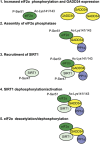Oxidative stress promotes SIRT1 recruitment to the GADD34/PP1α complex to activate its deacetylase function
- PMID: 28984870
- PMCID: PMC5762841
- DOI: 10.1038/cdd.2017.152
Oxidative stress promotes SIRT1 recruitment to the GADD34/PP1α complex to activate its deacetylase function
Abstract
Phosphorylation of the eukaryotic translation initiation factor, eIF2α, by stress-activated protein kinases and dephosphorylation by the growth arrest and DNA damage-inducible protein (GADD34)-containing phosphatase is a central node in the integrated stress response. Mass spectrometry demonstrated GADD34 acetylation at multiple lysines. Substituting K315 and K322 with alanines or glutamines did not impair GADD34's ability to recruit protein phosphatase 1α (PP1α) or eIF2α, suggesting that GADD34 acetylation did not modulate eIF2α phosphatase activity. Arsenite (Ars)-induced oxidative stress increased cellular GADD34 levels and enhanced Sirtuin 1 (SIRT1) recruitment to assemble a cytoplasmic complex containing GADD34, PP1α, eIF2α and SIRT1. Induction of GADD34 in WT MEFs paralleled the dephosphorylation of eIF2α (phosphoserine-51) and SIRT1 (phosphoserine-47). By comparison, eIF2α and SIRT1 were persistently phosphorylated in Ars-treated GADD34-/- MEFs. Expressing WT GADD34, but not a mutant unable to bind PP1α in GADD34-/- MEFs restored both eIF2α and SIRT1 dephosphorylation. SIRT1 dephosphorylation increased its deacetylase activity, measured in vitro and in cells. Loss of function of GADD34 or SIRT1 enhanced cellular p-eIF2α levels and attenuated cell death following Ars exposure. These results highlighted a novel role for the GADD34/PP1α complex in coordinating the dephosphorylation and reactivation of eIF2α and SIRT1 to determine cell fate following oxidative stress.
Conflict of interest statement
The authors declare no conflict of interest.
Figures









Similar articles
-
Chronic oxidative stress promotes GADD34-mediated phosphorylation of the TAR DNA-binding protein TDP-43, a modification linked to neurodegeneration.J Biol Chem. 2018 Jan 5;293(1):163-176. doi: 10.1074/jbc.M117.814111. Epub 2017 Nov 6. J Biol Chem. 2018. PMID: 29109149 Free PMC article.
-
Complementary Roles of GADD34- and CReP-Containing Eukaryotic Initiation Factor 2α Phosphatases during the Unfolded Protein Response.Mol Cell Biol. 2016 Jun 15;36(13):1868-80. doi: 10.1128/MCB.00190-16. Print 2016 Jul 1. Mol Cell Biol. 2016. PMID: 27161320 Free PMC article.
-
SIRT1 associates with eIF2-alpha and regulates the cellular stress response.Sci Rep. 2011;1:150. doi: 10.1038/srep00150. Epub 2011 Nov 9. Sci Rep. 2011. PMID: 22355666 Free PMC article.
-
The PPP1R15 Family of eIF2-alpha Phosphatase Targeting Subunits (GADD34 and CReP).Int J Mol Sci. 2023 Dec 10;24(24):17321. doi: 10.3390/ijms242417321. Int J Mol Sci. 2023. PMID: 38139150 Free PMC article. Review.
-
An Overview of Methods for Detecting eIF2α Phosphorylation and the Integrated Stress Response.Methods Mol Biol. 2022;2428:3-18. doi: 10.1007/978-1-0716-1975-9_1. Methods Mol Biol. 2022. PMID: 35171470 Review.
Cited by
-
Buyang Huanwu Decoction Targets SIRT1/VEGF Pathway to Promote Angiogenesis After Cerebral Ischemia/Reperfusion Injury.Front Neurosci. 2018 Dec 4;12:911. doi: 10.3389/fnins.2018.00911. eCollection 2018. Front Neurosci. 2018. PMID: 30564092 Free PMC article.
-
The HMGB1-RAGE/TLR-TNF-α signaling pathway may contribute to kidney injury induced by hypoxia.Exp Ther Med. 2019 Jan;17(1):17-26. doi: 10.3892/etm.2018.6932. Epub 2018 Nov 6. Exp Ther Med. 2019. PMID: 30651760 Free PMC article.
-
Lysine Acetylome Study of Human Hepatocellular Carcinoma Tissues for Biomarkers and Therapeutic Targets Discovery.Front Genet. 2020 Sep 17;11:572663. doi: 10.3389/fgene.2020.572663. eCollection 2020. Front Genet. 2020. PMID: 33093847 Free PMC article.
-
Updates on the epigenetic roles of sirtuins.Curr Opin Chem Biol. 2019 Aug;51:18-29. doi: 10.1016/j.cbpa.2019.01.023. Epub 2019 Mar 12. Curr Opin Chem Biol. 2019. PMID: 30875552 Free PMC article. Review.
-
Polysaccharides From Pogostemon cablin (Blanco) Benth.: Characterization and Antioxidant Activities.Front Pharmacol. 2022 Jun 16;13:933669. doi: 10.3389/fphar.2022.933669. eCollection 2022. Front Pharmacol. 2022. PMID: 35784681 Free PMC article.
References
-
- Wang M, Kaufman RJ. Protein misfolding in the endoplasmic reticulum as a conduit to human disease. Nature 2016; 529: 326–335. - PubMed
Publication types
MeSH terms
Substances
LinkOut - more resources
Full Text Sources
Other Literature Sources
Molecular Biology Databases

